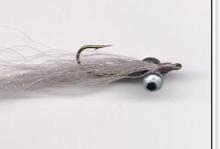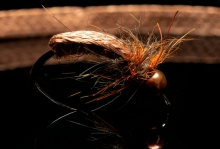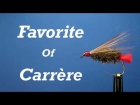Bass on Buzzers
If you ask an experienced largemouth bass fly angler for an account of his or her most productive patterns, a nymph of any variation would likely not be on the list.
Most anglers are aware that unfished bass, say, from a farm pond, are eager to strike most anything. They've yet to be hooked and thus haven't yet developed discretion for the food they'll hunt. However, these waters are rarer and rarer, so the majority of us cut our teeth and catch our fish in mid to high pressured water where the fish practice caution.
The common bass isn't so willing to gulp down an object on the basis it moves and fits in the bass' mouth. We can be certain that any fish over the age of two has been hooked at least once, if not many times. By the time an individual has reached trophy size she's likely to have learned to be highly discriminatory, not only shying away from the ill hid hook but certain lures and patterns that have proven to be hiding a hook.
Thus, it is ironic many anglers forget to take into account pressure when thinking of lure selection per the common, high pressured water. We're more apt to ask “what does a bass like?” as opposed to the equally important question “what have these bass learned to avoid?”
I
Bass are gluttons for baitfish and crawfish, frogs, the larger insect, and sometimes the unlucky fledgling. To account for this appetite spin fisherman are fans of the spinnerbait, large worm, creature-bait, and crank-bait, to list the most popular-- essentially, those lures whose flash and presence are used to elicit a bite more than any realistic physical relation to a food source. By contrast the bass fly angler is fond of patterns whose profile resembles a known food source, though the employed colors and sizes of these patterns are far less than restrictive, e.g., a bright purple wooly bugger is more likely a sight than a living, bright purple leech.
Surviving a battery of oversized, flashy, and charismatic lures for the bass means resorting to smaller food sources. Sources of which she can be more sure isn't a lined hook in disguise-- nymphs and buzzers.
II
In the bid to find the proper lure that both fools a fish and is novel, the fly fisherman is already at an advantage, yet does not fully utilize this advantage.
Flies usually differ from traditional lures in that they're smaller and likely more realistic but this not enough. In my experience pressured bass will not only “go off” of particular categories of lure but size of prey. Luckily, rarely do spin lures and not many bass fly patterns are found to fit a size 14 hook.
My first lesson in nymphing for bass came during my first session of fly fishing. I decided to take my "new" outfit (a 30 year old Sear's glass rod with an antique reel, and discount Cortland 333 line) to my local bluegill honey-hole, a midsize pond fed by a waterfall, that feeds into a small creek, that all flows beside a freeway. It's known for possessing plenty of large bass and carp, whose size are equal in their ability to avoid capture.
At this time I had no clousers, dahlberg divers, or buggers. But I did have a mutated, soft hackle prince nymph, size 12-ish. A few bluegills into the foray and my nymph disappears delicately from just below the surface. The hook is set and 3 minutes later I've caught a fair sized bass. Over the course of the remaining season this technique would be practiced regularly.
III
Of the aquatic insects most prescribed to imitate are chironomids (buzzers) and damsel fly nymphs, since mayflies and stoneflies are not common in bass waters
Of the aquatic insects most prescribed to imitate are chironomids (buzzers) and damsel fly nymphs, since mayflies and stoneflies are not common in bass waters
Many have a habit of slowly stripping a buzzer, as if it were natural for these creatures to glide horizontally through water in small bounds. But if one observes them in nature or in jar it's evident that agile swimming is not their modus operandi. Instead they kick and twitch, either fighting to catch ground or break the water's surface. The angler should follow in suite with his fly. Life should be breathed into the pattern with quick strips and/or flicks of the rod.
For damselflies too, realism is more important than “flash.” Damselfly nymphs spend their days camouflaged amongst foliage, flitting spot to spot in search of prey. Presentation style should, again, follow ethology: longer strips punctuated by a twitch, followed by a pause; exaggerated action supplanted for realistic movement. Those bass who prey on nymphs are adept at doing so and will have no trouble spotting your fly.
As to choosing a fly, consider as you would while fly fishing for bass in winter-- choose patterns closer to realism than not and smaller than your typical bass fly. Remember, you are endeavoring to present the fish with a lure she's never or not often has seen. Its then intelligent to note whether the water is often fly fished for panfish (bluegill, pumpkinseeds, or even crappie), however unlikely that may be. In which case the angler may need to exclude the overly flashy and “buggy” patterns from his arsenal.
You can toss your clousers and bugs because the PTN is here
IV
To reiterate: when facing a well pressured water, consider those patterns less often used. As voracious as bass are inclined to be, being caught is a traumatic event and one should not discredit the dissuading power of having a large hook run through the mouth.
Though not to be mistaken: nymphs are not being advocated as a new, super fly for bass, “you can toss your clousers and bugs because the PTN is here.”
Rather, I implore the bass angler to take into account the factor of pressure on his fishery and let this guide his or her hand more readily in fly selection.
Read more about why you should register.
More content from the front page
Since you got this far …
… I have a small favor to ask.
Long story short
Support the Global FlyFisher through several different channels, including PayPal.
Long story longer
The Global FlyFisher has been online since the mid-90's and has been free to access for everybody since day one – and will stay free for as long as I run it.
But that doesn't mean that it's free to run.
It costs money to drive a large site like this.
See more details about what you can do to help in this blog post.





























































